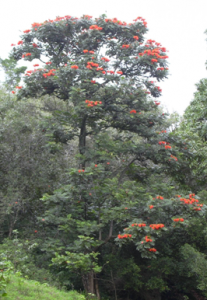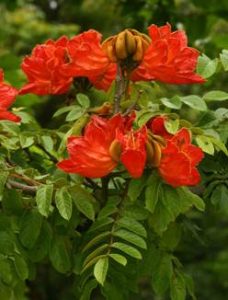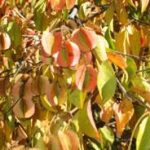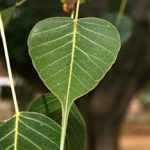TREE LIFE
July 2016
MASHONALAND CALENDAR
Saturday 2nd July: Botanic Garden Walk. Meet in the car park at 0845 to start at 0900 hours. The garden is looking good and there is always something spectacular to see. Join us for 1.5 hours of pleasure.
Sunday 17th July: Henry Hallam Dam: During a recent check, we found the woodland near the wall is still in good condition so we will meet at the Mukuvisi Woodland car park at 0845 for 0900 hours departure. Bring all you need for the day – chairs, picnic, tea, hat etc. There is a $2 per person entrance fee.
Saturday July 23rd: Haka Game Park: We will cross the vlei to the interesting woodland and river on the other side. Meet at the gate at 1415. I am hoping to get a reduced entry fee for the group, you will be advised if this happens.
PLANTED TREES OF HARARE
Spathodea campanulata

Spathodea campanulata tree
Spathodea campanulata – the African Tulip Tree or Flame Tree is a commonly planted tree in Harare and lines several major roads, including Seventh Street. Spathodea (pronounced in Zimbabwe as Spath-oh-dee-uh but Kenyan-born Roger Leaky pronounces it as Spatho-dee-uh) is a monotypic genus in the family Bignoniaceae, whose name comes from the Greek description of its spathe-like calyx. The tree is native to Angola, Ethiopia, Ghana, Kenya, Sudan, Tanzania and Uganda and was first seen by Europeans in 1787 on the Gold Coast (now Ghana). The book ‘The Flame Trees of Thika’, written about an English pioneering farming family in Kenya, was named after this tree

Spathodea campanulata flowers
This is a large tree, between 7-25m in height, that is planted extensively as an ornamental tree throughout the tropics, appreciated for its very showy reddish–orange, crimson or rarely yellow, campanulate flowers. The flower bud is ampule-shaped and contains water. The buds are often used by children who play with their ability to squirt water, the sap sometimes staining yellow on fingers and clothes. The open flowers are cup-shaped and hold rain and dew, making them attractive to many species of birds. The nectar is also popular with birds.

Spathodea campanulata pod
The large compound leaves (up to 50cm) are imparipinnate, with opposite, ovate to elliptic leaflets. The fruit is a boat-shaped, fusiform capsule that is held erect and encloses winged seeds. The wood is soft enough for many hole-building birds such as Barbets to build their nests in it. The soft wood is quite susceptible to butt and heart rot and it rots quickly when in contact with the ground. Unfortunately this beautiful tree has become invasive in some tropical areas.
References:
Zimbabwe Flora: Spathodea campanulata www.zimbabweflora.co.zw
Wikipedia:https://en.wikipedia.org/wiki/Spathodea
– Isla Grundy
OUTING TO DOMBOMBIRA PLOT 14 RUWA, 19TH JUNE, 2016
Due to the prevailing “cash crisis” it was decided to find venues closer to Harare for our monthly visits until such time as we can see if the situation improves.
On Sunday seven of us traveled out to Dombombira Plot 14, about 10km from Ruwa on the Chiremba Road. This lovely property is being developed by Wendy and Rob Frederickson as a venue for weddings, gatherings, a place for family outings in beautiful surroundings but most of all as an educational/interpretative center for school children, both from the area and from afar. The Society had been approached by Wendy to identify the indigenous trees on the property.
We were warmly welcomed by Wendy and Rob and their daughter Angela and two young men who assist the Fredericksons with their endeavours. It was evident as the day unfolded that we were to have a most interesting time assisting in the identification and labelling of the indigenous trees. Rob’s assistant No Rest and his helpers did a wonderful job of recording the trees with speedy labelling by means of numbers specific to the site itself.
Copies of Lyn Mullin et al’s ‘Zimbabwean Botanical Checklist’ were of great assistance in clarifying Shona, common and botanical names and as usual we had our checklists to tick off what we saw. When we were uncertain of a species we took a sample for later verification.
It is a wonderful spot for school children and learners of all ages to get a feeling for our wonderful environment, with even a small museum to encourage interest in the flora, fauna, trees, birds, reptiles, mammals, artifacts, pottery shards and other items found within the impressive granite outcrops and surrounds. Another much appreciated find was all the bushmen paintings and grinding holes with access made easier with clear direction finders.
Tree List:
Ficus capensis; Celtis africana (White Stinkwood); Clerodendrum eriophyllum (Hairy tinderwood or White Cats Whiskers, flowers in whorls, hairy leaves, soft texture); Ficus natalensis; Vitex payos (Chocolate Berry, Musubvu), with palmate leaf, furry on upper side); Parinari curatellifolia (Muhacha); and an Acacia from which we could reach no leaf easily, though a twig with leaves fallen had small paired thorns. Tony explained that when such trees are small and vulnerable, the thorns are more abundant and larger to protect the new growth.
What we thought were Bauhinia galpinnii with red flowers on the kopjes turned out to be Pterolobium stellatum on closer examination and the red “flowers” were actually the redwing seedpod.
We also found Azanza garckeana or Snot Apple, the fruit tasting of bubblegum when eaten which has a multilobed leaf, with a gland on the central vein providing exudate for ants; Dombeya rotundifolia; Combretum molle (The ‘Wish’ Tree, Mupumbere), with a soft furry leaf. At this point Alex was able to explain that in Shona mu = one and mi = lots or the plural.
Allophylus africanus; Turraea nilotica with yellow green leaves, crinkley in appearance, or as one person said rather reminded her of crimplene! Erythrina abyssinica or Lucky Bean Tree; Cussonia arborea (Cabbage Tree); Pseudolachnostylis maprouneifolia with galls on its leaves; Euclea (Blue Guarri or Blue-leaved Euclea); Salvadora persica (Mustard or Toothbrush Tree) which appeared more like a shrub; Vangueria randii (Munsviro, Anthill Wild Medlar); Strychnos spinosa (Monkey Apple) with smooth bark; Strychnos cocculoides with corky bark – Interesting comparing the two. Albizia antunesiana (Purple leaf Albizia) with shaving brush flowers; Pavetta schumanniana has a fascinating leaf: spongy, with pronounced veins, looking like crimplene, so there was discussion about the Turraea nilotica seen previously; Julbernardia globiflora (Munondo), with pods on top; Ximenia caffra (Sour Plum, Munengeni); Dichrostachys cinerea (Chinese lantern) with its very characteristic pink and yellow flowers; Dombeya burgessiae with pink flowers, which go brown; Lannea discolor (Livelong, Mumbumbu); Grewia monticola; Erythrina lysistemon; Searsia longipes (ex Rhus longipes); Combretum erythrophyllum (River bush willow); Eucalyptus citriodora (Lemon scented gum); Ziziphus mucronata; Mystroxylon aethiopicum (Kooboo Berry, Mundangwa) with its crackling leaf; Flacourtia indica; the exotic Casimiroa edulis (Mexican Apple) with a palmate leaf; Pavetta gardeniifolia; Ochna puberula; Senna singueana; Diospyros lycioides.
In all we identified and labelled 43 species and we hope our endeavours will be of use to Rob and Wendy in their endeavours to pass information on to the school children who visit.
There was also Cotoneaster, Citharexylum spinosum– Lady Chancellor; Hibiscus, Jasmine, Petrea, Jacarandas, Pride of India, Bauhinia, and Privet, all seen planted as garden colour in days gone by.
We had good chats and discussions afterwards, with our picnic lunches under the trees surrounded not too far away by rescued animals of all kinds, all lovingly cared for and restored to health. A very good day had by Alex, Graham, Bilal, Tony, Richard, Sarah and Mary. Our grateful thanks to our hosts.
– Sarah Roberts and Mary Lovemore
BOTANIC GARDEN WALK – 4TH JUNE 2016
Another glorious winter day – seven of us braved the potentially cold and cloudy early morning to enjoy yet another “walk in the park”. We first payed homage to Mrs Baboon Spider (her portrait appeared in last month’s Tree Life) and also admired the Combretum celastroides which was still as showy as it had been last month, only much drier.
Our mission was Hexalobus monopetalus (Tony had requested to see the tree) and we were kept on course by Chris, who we were delighted had time to join us for the morning. So it was “Mission Hexalobus” but with many stops along the way, the first being with Phyllanthus reticulatus, the Potato Bush, which was in full bud. We are all familiar with the strong scent of potatoes during certain times of the year, particularly on spring and summer evenings. Browsed by game and stock, the leaves and fruit are used medicinally and the fruit produce a black dye. (When our children were young and we had not been able to get into the bush during the holidays, the best we could do was to take them for a walk in the evenings in Tom’s Garden to get a “whiff of the bush”).
We then stopped to pick Carissa edulis (Simple-spined Num-num) we were not very lucky as there were only a few left to be had, the fruit fleshy, oval, purplish black and sweet and juicy. They make good jam and jelly and are also used to kill intestinal worms in humans and cattle. The crushed roots have the characteristic smell of oil of wintergreen and are widely used in traditional medicine.
We came across a Dalbergia but there was a debate on which Dalbergia which was not resolved. We also found Ormocarpum zambesiaca which is endemic to the Zambezi Valley and Flueggea virosa (Snowberry), a many-stemmed shrub or small tree whose strong and supple wood is used for fish traps. It is similar to Phyllanthus reticulatus, but easily distinguished by the angular young twigs. Nearby was Searsia lancea [ex Rhus lancea] just about to burst into flower, whose bark was used for tanning. The branchlets once were used to make bows and when the fruit is pounded with water it can be brewed into a tasty beer! It is widely cultivated as a garden ornamental and is drought and frost resistant.
Xeroderris stuhlmannii (Wing-pod/Wing Bean) was heavily in fruit, its pods flat and conspicuously swollen over the seeds. The bark exudes a red sap when cut and the hard dark yellow wood forms a good timber. The red sap is used as a dye or for tanning leather and the seeds are ground to produce a meal. Pavetta gardeniifolia (Common Bridesbush), whose white to cream flowers are heavily scented. Antidesma venosum (Tassel-berry) with its glossy, bright green leaves and whose flowers are said to have an offensive smell, has fruit that hang in tassels and are white when young becoming bright red and finally purplish black. Chris tells us that as a child the juice from the red berries were squeezed into the cartridge of a pen and – hey – pink ink!
Teclea nobilis was confused with Vepris reflexa but later sorted out by Meg. Then we came across Tamarindus indica which is a favourite. The acid-sweet fruit pulp is edible and used for preserves, jams, sweets, refreshing drinks and in curries and chutneys. Flowers, leaves and crushed seeds are added to relishes and side dishes. Over-ripe fruit is used to polish silver, copper and brass ornaments. The wood is dark brown, suitable for carpentry – what a useful tree to have in your garden.
We admired Ficus chirindensis (Fairytale or Hollow Trunk Fig); Dracaena mannii, the Small-leaved Dragon-tree, and Zanha golungensis, the smooth-fruited Zanha. The huge Ziziphus mucronata (Buffalo-thorn) was noted to have no thorns and it was surmised that maybe after a certain size the tree feels no need to defend itself, so no longer produces thorns? The leaves are browsed by game and stock and are widely used for magical and medicinal purposes and in traditional religious rituals. The juice from the tree is used by the San as a mixing agent for arrow poison obtained from the larvae of Diamhidia nigroornata, a beetle that feeds on the leaves of Commiphora africana.
The Gardenia resiniflua was covered in very attractive fruit. A small Diospyros usambarensis had grown itself into a most delightful sort of bonsai-ed shape; Ficus sur, the Broom Cluster Fig, is always lovely to look at. There was much debate about a lumpy-skinned Strychnos fruit, but Meg assured us it was Strychnos spinosa. And then, finally, in this really attractive corner of the Garden, was our target Hexalobus monopetalus (Shakama Plum), a small crooked tree occurring in rocky places or riverine thicket. Right next to it was Monodora junodii (Green Apple) whose large flowers are solitary, drooping and attractive, lime green tinged with maroon, reddish brown to wine red and faintly scented.
Spirostachys africana (African Sandlewood or Tamboti) was the next tree in its yellow reddish autumn colours. The timber should not be used as fuel as inhalation of the smoke causes headache and nausea and food directly exposed to the smoke is said to become poisonous. And then Erythrophleum africanum, the Ordeal Tree. The bark, roots and leaves are poisonous and the bark exudes an amber coloured gum comparable to Gum Arabic. The poison concoction is used for “trying” those who are suspected of some crime. The suspect is made to drink the concoction and if he/she dies is presumed guilty – sort of being between a rock and a hard place!
Plenty more were looked at and discussed – what a delightful way to spend a winter’s morning, and what interesting discussions we had – thanks to Chris, Meg, Tony, Dave, Ann and Bilal for all contributions.
– Mary Lovemore
BOTANIC GARDEN WALK – 2ND JULY 2016
Where have all the people gone?? Where has all the interest gone?? What are we lacking?? Are we a dying Society??? Have you, the members, got any good ideas???
On this very lovely, slightly warmer, crisp winter morning there were only two takers for the Botanical Garden walk – Dave Hartung and Mary Lovemore!! We had a good walk, the garden is looking good, the staff are really trying with their VERY limited resources. We then had a welcome cup of coffee basking in the sunshine and solved most of the affairs of State!!
– Mary Lovemore
THE NICKEL ANOMALY ON WEDZA MOUNTAIN
An area such as this, where vegetation differs markedly from surrounding associations, is known as an anomaly. Nickel is thought to be the heavy metal most toxic to plant growth, followed by copper. Moreover, the effects of this toxicity are manifest in the vegetation in different ways on copper and on nickel soils. Professor Wild of the University’s Botany Department has recorded a total of 436 species occurring in copper soils throughout Rhodesia and only 302 on nickel soils.
Numbers on each particular anomaly are, of course, far less. On the very strong one near the old Wedza Mine, for example, a total of only 17 species of grasses, herbs and trees has been found. Thus, a very reduced number of species can immediately indicate the presence of heavy metal in the soil. The species themselves give a further indication. On the Wedza anomaly, in an area surrounded by a common musasa / mufuti woodland, the dominant tree is stunted Combretum molle.
Suspicions are further confirmed by the presence of the soft, woolly herb Dicoma macrocephala in numbers on the area, since a form or perhaps a subspecies of this plant seems to be found only on nickel soils in Rhodesia. The plant has earned the name of “Nickel flower”.
This and other plants have the ability to take up nickel which is of no use to them and remain unaffected. The analysis of the leaves of such plants for heavy metals forms the basis for “Biogeochemical” prospecting. This method is presently being employed using vegetation growing on the wind blown Kalahari sands to determine whether the under lying rocks contain economic minerals. On this trip we will only be able to examine a tiny part of these huge mountains that vary so much in all their aspect. Perhaps this should be the beginning of a series of visits. There is a move to have the Wedza Mountains declared a Nature Reserve and if this happens it could become more accessible which would certainly make future trips easier.
In producing these notes I must acknowledge the information gleaned from:
The Geology of the Country South and East of Wedza by P. Fey, M.Sc. Geological Survey Bulletin No 77; A visit to the Wedza Mountain by J.N.Talbot and Conservation Plan, Wedza Mountain, a report to Natural Resources Department by Thomas Muller.
– Meg Coates Palgrave
Tree Life 16: July 1981
TONY ALEGRIA



